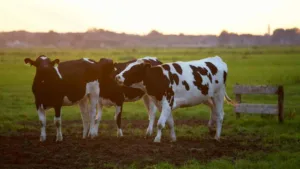Genetically modified cows produce milk with human insulin proteins
A genetically modified cow produced the proteins needed for human insulin in its milk, and the scientists behind the experiment have high hopes that a herd of these cattle could solve the world’s insulin supply problems.
Genetically modified cows produce milk with human insulin proteins. If such a herd were viable, which is currently a long way off, the researchers believe it could outperform current methods of insulin production, which rely on genetically modified yeast and bacteria.
Insulin and its role in diabetes were first discovered in 1921, and for many years, diabetics were treated with insulin derived from the pancreas of cattle and pigs.
However, in 1978, the initial production of “human” insulin occurred through the utilization of proteins derived from genetically modified E. coli bacteria, which, along with similar processes using yeast instead of bacteria, is the main source of medical insulin to this day.
While turning to cows to provide human insulin is nothing new, this new study is the first time that production of “human” insulin has been achieved in genetically modified cattle.
How was the experiment done?
The research team, led by scientist Matt Wheeler from the University of Urbana-Champaign in Illinois, USA, inserted a specific segment of human DNA that codes for proinsulin (a protein that is converted into insulin) into the cell nuclei of 10 cow embryos, which were then introduced into the uteruses of normal cows.
Only one of these genetically modified embryos developed into a pregnancy, leading to the natural birth of a live, transgenic calf.
When this genetically modified cow reached maturity, researchers made several attempts to inseminate her artificially or naturally, without success. They noted that this may have more to do with how the embryo was created than with the fact that it was genetically modified.
They finally managed to get the cow to produce milk through hormonal induction, using an unknown method attributed to animal breeding technologist Pietro Baruselli from the University of Sao Paulo.
The cow was not lactating as much as she normally would if she were pregnant, but the little milk she produced over the course of a month was analyzed to look for specific proteins.
The researchers identified two components in the milk with a molecular mass akin to human proinsulin and insulin, absent in regular milk from non-transgenic cows. Additionally, they found the presence of C-peptide, typically eliminated from human proinsulin when producing insulin. This implies that enzymes in the transgenic cow’s milk likely transformed “human” proinsulin into insulin.
The researchers stated,
“Our objective was to produce proinsulin, refine it into insulin, and assess our progress from that point forward.” But the cow essentially processed it herself. It produces about a 3-to-1 ratio of biologically active insulin to proinsulin,” Wheeler said.
In 2014, a similar type of genetic modification was achieved in mice whose milk contained up to 8.1 grams per liter of human proinsulin. Comparable concentrations were not reported in this new study, but that didn’t stop Dr. Wheeler from considering scaling up the new venture.
A standard unit of insulin is 0.0347 milligrams, so if, as Wheeler suggests, each cow could produce one gram of insulin per liter of milk, that’s 28,818 units of insulin.
Specialized high-level cattle health facilities would be required for endeavors like this, but such requirements are not uncommon for our well-established dairy industry. I could see a future where a herd of 100 cows could produce all the insulin a country like the US needs. And a larger herd could produce the insulin we need for the entire world within a year!

